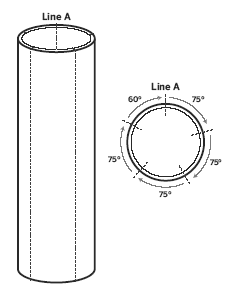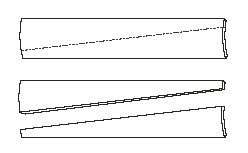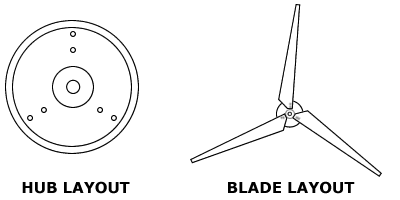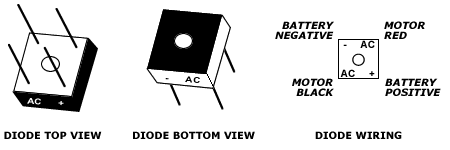NOTE: THE MAKE MAGAZINE ARTICLE SHOWS THE BLADES BEING CUT FOR A CW ROTATION. IF YOU ARE USING THE TREADMILL MOTOR MENTIONED IN THE ARTICLE PLEASE CUT THE BLADES PER THE WEBSITE INSTRUCTIONS.
Wind power is abundant, clean, inexpensive and easy to do. It is our belief that anyone can be in control of where his or her electricity comes from. There is nothing more rewarding and empowering than making a wind powered generator from scrap materials. Most of the tools and materials in this manual can be found in your local hardware shop or junk pile. We highly recommend you search your local dump and/or junkyards for the materials required. If you live in a city, do a search on freecycle.org for salvaged parts.
Safety should be our highest priority. Human life is more important than electricity, so please follow any and every safety guideline you come across. Wind generators can be very dangerous, with fast moving parts, electrical sparks, and violent weather conditions.
This manual is based on using a 260 VDC, 5 A continuous duty Treadmill Motor with a 6 inch threaded hub. For more information on how to pick a motor, or other parts, please read our parts section. We are getting about 7 amps in a 30 mph wind. In other words, it is a simple, cheap little machine to get you started.
You may use any other simple permanent magnet DC motor that returns at least 1 V for every 25 rpm and can handle upwards of 10 amps. If you do, there will be certain changes to this supply list (for example, you will have to find a hub – a circular saw blade with a 5/8″ shaft adaptor will work).
Mount
36″ of 1″ Square Tubing
2″ Floor Flange
2″ X 6″ Nipple
3 X 3/4″ Self-tapping Screws
NOTE: if you have access to a welder, you can weld a 6” section of 2” pipe onto your square tubing instead of using the flange, nipple and sheet metal screws.
Motor
260 VDC, 5 A continuous duty Treadmill Motor with a 6 inch threaded hub
30 – 50 Amp Blocking Diode (one-way)
2 x 5/16” x ¾” Motor Bolts
3″ X 11″ PVC Pipe
Tail
1 sqft (approx) lightweight material (metal)
2 X ¾” Self-tapping Screws
Blades
24″ length of 8″ PVC Pipe (if it is UV resistant, you will not need to paint it)
6 X ¼” X 20 Bolts
9 x ¼” washers
3 sheets A4 paper and tape
Drill
Drill Bits (7/32″, ¼”, 5/16″)
Jigsaw with a metal blade
Pipe Wrench
Flat Head Screwdriver
Crescent Wrench
Vise and/or Clamp
Wire Strippers
Tape Measure
Marker Pen
Compass + protractor
¼” #20 Thread Tapping Set
An extra person helps a lot!
Makes 9 blades (or 3 blade sets) and a thin waste strip.
 Place the 24″ Length of PVC pipe and square tubing (or other straight edge) side by side on a flat surface. Push the pipe tight against the tubing and mark the line where they touch. This is Line A.
Place the 24″ Length of PVC pipe and square tubing (or other straight edge) side by side on a flat surface. Push the pipe tight against the tubing and mark the line where they touch. This is Line A. Cut along these lines, using the jigsaw, so that you have 4 strips of 145 mm and one strip about 115 mm.
Cut along these lines, using the jigsaw, so that you have 4 strips of 145 mm and one strip about 115 mm.

You should sand the blades to achieve the desired airfoil. This will increase the efficiency of the blades, as well as making them quieter.
The angled (leading) edge wants to be rounded, while the straight (tailing) edge wants to be pointed.Any sharp corners should be slightly rounded to cut down on noise.
The exact dimensions of the tail are not important. You want about one square foot of lightweight material, preferably metal. You can make the tail any shape you want, so long as the end result is stiff rather than floppy
Using the 5/16” drill bit
Using the ¼” drill bit
Using the 7/32″ drill bit and ¼” tap
 Mark 3 holes, each of which is 2 3/8″ from the center of the circle and equidistant from each other.
Mark 3 holes, each of which is 2 3/8″ from the center of the circle and equidistant from each other.
 Connect the red wire coming out of the motor to the negative incoming terminal of the diode (Labeled AC on the negative side).
Connect the red wire coming out of the motor to the negative incoming terminal of the diode (Labeled AC on the negative side).For a longer life span of your wind generator, you should paint the blades, motor sleeve, mount and tail.
Use of Chispito Wind Generator
You will need a tower, wire, ammeter, charge controller/regulator, and a battery bank for your Chispito Wind Generator.
Tower
The tower is one of the most important components in your wind generator system. It must be strong, stable, easily raised and lowered, and well anchored. The higher your tower is, the more wind your generator will be exposed to. Guy wires must be placed at least every 18 feet of tower height. Guy wires must be anchored to the ground at least 50% of the height away from the base. For full tower instructions, please refer to our Tower How-To.